Objective 5. Navigate the Word Window
Because most Word documents are larger than the Word window, use scroll bars to navigatemove withina document. Keyboard shortcuts are another way to navigate your document quickly. Keyboard shortcuts provide additional navigation techniques that you cannot accomplish with scroll bars. For example, using keyboard shortcuts, you can move the insertion point to the beginning or end of a word or line.
Activity 1.13. Opening and Closing an Existing Document
|
1. |
Start Word if necessary. On the Standard toolbar, click the Open button |
|
2. |
In the Open dialog box, click the Look in arrow at the right edge of the Look in box to view a list of the drives available on your system. Compare your screen with Figure 1.28. Figure 1.28. 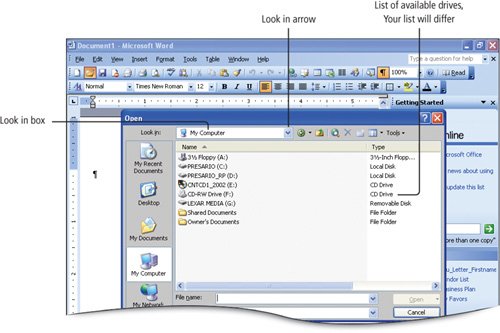
|
|
3. |
Navigate to the location where the student files for this textbook are stored, which might be on a CD that came with your textbook, or in some other location designated by your instructor. Locate w01B_Party_Themes and click once to select it. Then, in the lower right corner of the Open dialog box, click the Open button. Alternatively, double-click the file name. If necessary, on the Standard toolbar, click the Show/Hide ¶ button The document displays in the Word window, as shown in Figure 1.29. This text will be inserted into a new document in Activity 1.14. Figure 1.29. 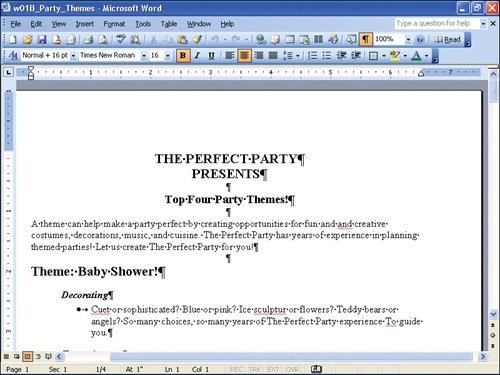
|
|
4. |
From the File menu, click Close to close the document and leave Word open. |
NoteTurning Off the Office Assistant
One of Word's Help features is an animated object called the Office Assistant. Many people like to turn off this feature. To hide the Office Assistant, click the right mouse button on the Office Assistant. In the menu that displays, click Hide. The instruction in this textbook assumes that the Office Assistant is turned off.
Activity 1.14. Inserting Existing Text into a New Document
|
1. |
From the File menu, click New, and then notice the New Document task pane to the right of the document window. Compare your screen with Figure 1.30. Figure 1.30. 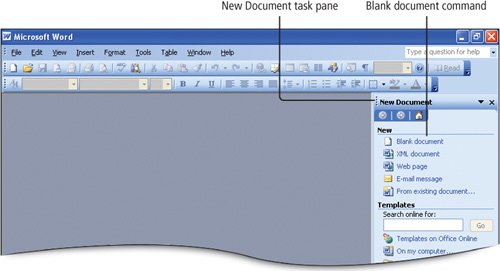
|
|
2. |
In the New Document task pane, under New, click Blank document. If necessary, on the Standard toolbar, click the Show/Hide ¶ button |
|
3. |
On the menu bar, click Insert, and then click File. In the Insert File dialog box, click the Look in arrow and navigate to the location where the student files for this textbook are stored. Locate w01B_Party_Themes, click once to select it, and then click the Insert button. Figure 1.31. 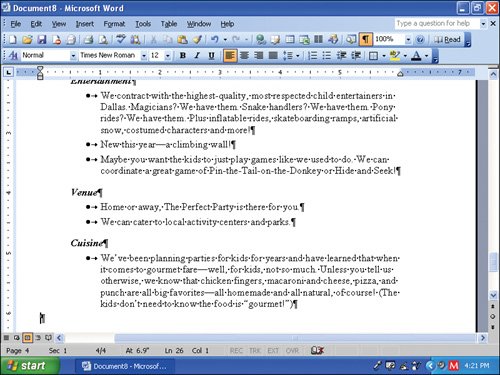
|
|
4. |
On the Standard toolbar, click the Save button |
|
5. |
In the File name box, delete any existing text, and then using your own first and last name, type 1B_Party_Themes_Firstname_Lastname and then click Save. |
|
6. |
From the View menu, click Header and Footer. On the Header and Footer toolbar, click the Switch Between Header and Footer button The file name is inserted in the footer. The file extension .doc may or may not display, depending on your computer's settings. |
|
7. |
Save |
Activity 1.15. Navigating a Document
|
1. |
At the right of your screen, in the vertical scroll bar, locate the up arrow at the top of the bar as shown in Figure 1.32. Then, click the up scroll arrow five times. Figure 1.32. 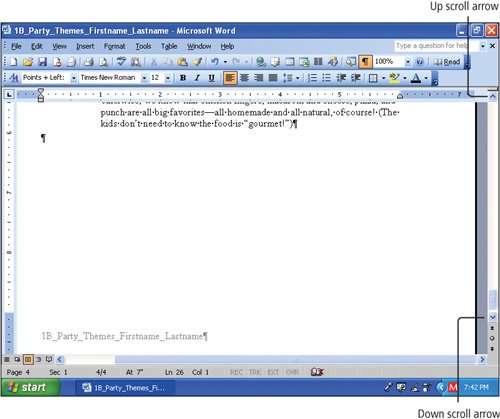
Notice that the document scrolls up one line at a time. |
||||||||||||||||||||||||||
|
2. |
Point to the up scroll arrow again. Click and hold down the mouse button for several seconds. |
||||||||||||||||||||||||||
|
3. |
At the top of the vertical scroll bar, point to the up scroll arrow, and then click and hold down the mouse button until you have scrolled to the top of the document. As you do so, notice that the scroll box moves up in the scroll barlike an elevator going to the top floor. |
||||||||||||||||||||||||||
|
4. |
Near the top of the vertical scroll bar, point to the scroll box, and then press and hold down the left mouse button. A ScreenTipa small box that displays information about, or the name of, a screen elementdisplays. In this instance, the ScreenTip indicates the page number, as shown in Figure 1.33. The page number and total number of pages in the document are displayed in the status barin this case page 1 of 4 pages. Figure 1.33. 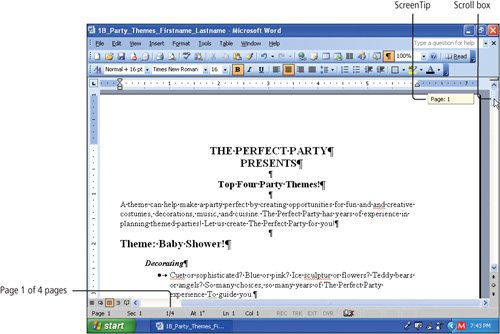
|
||||||||||||||||||||||||||
|
5. |
Draghold down the left mouse button while moving your mousethe scroll box slowly down to the bottom of the scroll bar. As you do so, notice that the ScreenTip changes as each new page reaches the top of the screen. |
||||||||||||||||||||||||||
|
6. |
Release the mouse button, and then click in the light area above the scroll box. |
||||||||||||||||||||||||||
|
7. |
Practice clicking in the area above and below the scroll box. Another Way: To ScrollUse the Wheel Button on the Mouse If your mouse has a small wheel button between the left and right mouse buttons, you can scroll up and down in the document by rotating the wheel. |
||||||||||||||||||||||||||
|
|
|||||||||||||||||||||||||||
|
8. |
On your keyboard, hold down |
||||||||||||||||||||||||||
|
9. |
Hold down |
||||||||||||||||||||||||||
|
10. |
Press
|
||||||||||||||||||||||||||
|
11. |
Hold down |
Activity 1.16. Changing Views and Displaying the Task Pane
|
1. |
In the lower left corner of your screen, to the left of the horizontal scroll bar, locate the View buttons. Another Way: To View Documents There are five ways to view your document on the screen. Each view is useful in different situations.
|
|
2. |
Click the Normal View button The work area covers the entire width of the screen. Page margins, inserted graphics, headers, and footers do not display. Compare your screen with Figure 1.35. Figure 1.35. 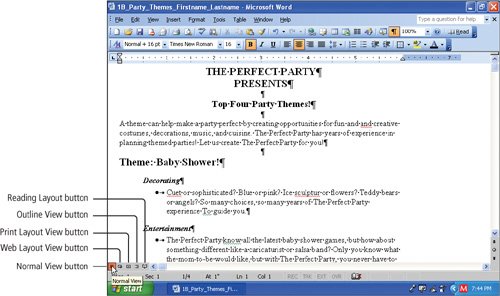
|
|
3. |
Click the Reading Layout button NoteOpening the Reading Layout View The Reading Layout view is also accessible by clicking the Read button |
|
4. |
At the top of the screen, in the Reading Layout toolbar, click Close |
|
|
|
|
5. |
At the left of the horizontal scroll bar, click the Print Layout View button |
|
6. |
From the View menu, click Task Pane. At the top of the task pane, click the Other Task Panes arrow to the right of the task pane name, and from the displayed list, click Getting Started. Compare your screen with Figure 1.36. Figure 1.36. 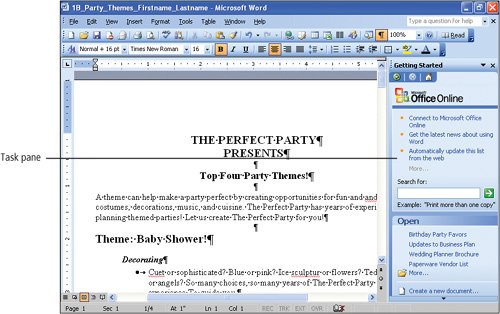
As you progress in your study of Word, you will see various task panes to assist you in accomplishing Word tasks. |
|
|
|
|
7. |
From the View menu, click Task Pane again to close the task pane. Alternatively, click the task pane Close button. |
Activity 1.17. Using the Zoom Button
To zoom means to increase or decrease the viewing area of the screen. You can zoom in to look closely at a particular section of a document, and then zoom out to see a whole page on the screen. You can also zoom to view multiple pages on the screen.
|
1. |
On the Standard toolbar, click the Zoom button arrow Figure 1.37. 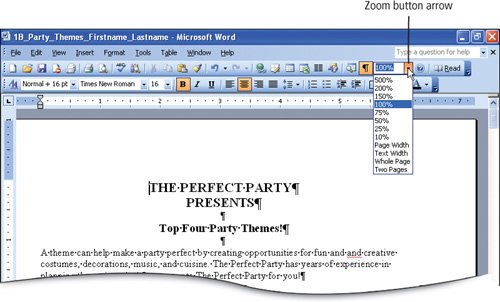
|
|
|
|
|
2. |
On the displayed list, click 150% to magnify the view of the text as shown in Figure 1.38. Figure 1.38. 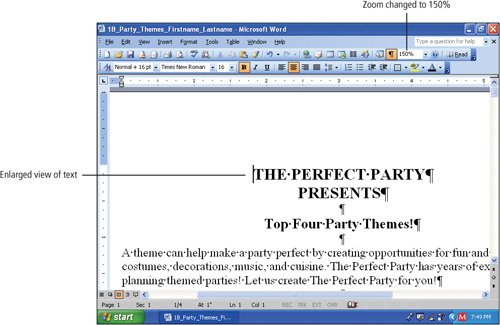
|
|
3. |
On the Standard toolbar, click the Zoom button arrow |
|
4. |
On the vertical scroll bar, click the down scroll arrow five times. Notice that you can now see parts of four pages, and you can see how the text flows from one page to another. Compare your screen with Figure 1.39. Figure 1.39. 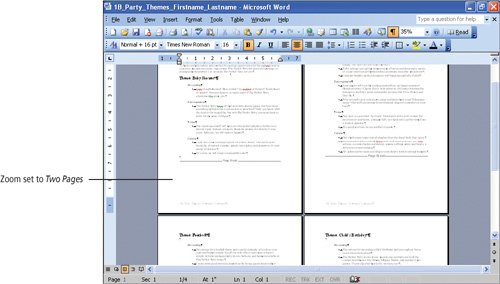
|
|
5. |
On the Standard toolbar, click the Zoom button arrow |
|
6. |
On the Standard toolbar, click on the number in the Zoom box to highlight the number currently displayed. Type 100 and then press |
|
[Page 273 (continued)] Objective 6 Add a Graphic to a Document |
Windows XP
- Chapter One. Getting Started with Windows XP
- Project 1A. Windows XP
- Objective 1. Get Started with Windows XP
- Objective 2. Resize, Move, and Scroll Windows
- Objective 3. Maximize, Restore, Minimize, and Close a Window
- Objective 4. Create a New Folder
- Objective 5. Copy, Move, Rename, and Delete Files
- Objective 6. Find Files and Folders
- Objective 7. Compress Files
- Summary
- Key Terms
- Concepts Assessments
Outlook 2003
- Chapter One. Getting Started with Outlook 2003
- Getting Started with Microsoft Office Outlook 2003
- Project 1A. Exploring Outlook 2003
- Objective 1. Start and Navigate Outlook
- Objective 2. Read and Respond to E-mail
- Objective 3. Store Contact and Task Information
- Objective 4. Work with the Calendar
- Objective 5. Delete Outlook Information and Close Outlook
- Summary
- Key Terms
- Concepts Assessments
- Skill Assessments
- Performance Assessments
- Mastery Assessments
- Problem Solving
- GO! with Help
Internet Explorer
- Chapter One. Getting Started with Internet Explorer
- Getting Started with Internet Explorer 6.0
- Project 1A. College and Career Information
- Objective 1. Start Internet Explorer and Identify Screen Elements
- Objective 2. Navigate the Internet
- Objective 3. Create and Manage Favorites
- Objective 4. Search the Internet
- Objective 5. Save and Print Web Pages
- Summary
- Key Terms
- Concepts Assessments
- Skill Assessments
- Performance Assessments
- Mastery Assessments
- Problem Solving
Computer Concepts
- Chapter One. Basic Computer Concepts
- Objective 1. Define Computer and Identify the Four Basic Computing Functions
- Objective 2. Identify the Different Types of Computers
- Objective 3. Describe Hardware Devices and Their Uses
- Objective 4. Identify Types of Software and Their Uses
- Objective 5. Describe Networks and Define Network Terms
- Objective 6. Identify Safe Computing Practices
- Summary
- In this Chapter You Learned How to
- Key Terms
- Concepts Assessments
Word 2003
Chapter One. Creating Documents with Microsoft Word 2003
- Chapter One. Creating Documents with Microsoft Word 2003
- Getting Started with Microsoft Office Word 2003
- Project 1A. Thank You Letter
- Objective 1. Create and Save a New Document
- Objective 2. Edit Text
- Objective 3. Select, Delete, and Format Text
- Objective 4. Create Footers and Print Documents
- Project 1B. Party Themes
- Objective 5. Navigate the Word Window
- Objective 6. Add a Graphic to a Document
- Objective 7. Use the Spelling and Grammar Checker
- Objective 8. Preview and Print Documents, Close a Document, and Close Word
- Objective 9. Use the Microsoft Help System
- Summary
- Key Terms
- Concepts Assessments
- Skill Assessments
- Performance Assessments
- Mastery Assessments
- Problem Solving
- You and GO!
- Business Running Case
- GO! with Help
Chapter Two. Formatting and Organizing Text
- Formatting and Organizing Text
- Project 2A. Alaska Trip
- Objective 1. Change Document and Paragraph Layout
- Objective 2. Change and Reorganize Text
- Objective 3. Create and Modify Lists
- Project 2B. Research Paper
- Objective 4. Insert and Format Headers and Footers
- Objective 5. Insert Frequently Used Text
- Objective 6. Insert and Format References
- Summary
- Key Terms
- Concepts Assessments
- Skill Assessments
- Performance Assessments
- Mastery Assessments
- Problem Solving
- You and GO!
- Business Running Case
- GO! with Help
Chapter Three. Using Graphics and Tables
- Using Graphics and Tables
- Project 3A. Job Opportunities
- Objective 1. Insert and Modify Clip Art and Pictures
- Objective 2. Use the Drawing Toolbar
- Project 3B. Park Changes
- Objective 3. Set Tab Stops
- Objective 4. Create a Table
- Objective 5. Format a Table
- Objective 6. Create a Table from Existing Text
- Summary
- Key Terms
- Concepts Assessments
- Skill Assessments
- Performance Assessments
- Mastery Assessments
- Problem Solving
- You and GO!
- Business Running Case
- GO! with Help
Chapter Four. Using Special Document Formats, Columns, and Mail Merge
- Using Special Document Formats, Columns, and Mail Merge
- Project 4A. Garden Newsletter
- Objective 1. Create a Decorative Title
- Objective 2. Create Multicolumn Documents
- Objective 3. Add Special Paragraph Formatting
- Objective 4. Use Special Character Formats
- Project 4B. Water Matters
- Objective 5. Insert Hyperlinks
- Objective 6. Preview and Save a Document as a Web Page
- Project 4C. Recreation Ideas
- Objective 7. Locate Supporting Information
- Objective 8. Find Objects with the Select Browse Object Button
- Project 4D. Mailing Labels
- Objective 9. Create Labels Using the Mail Merge Wizard
- Summary
- Key Terms
- Concepts Assessments
- Skill Assessments
- Performance Assessments
- Mastery Assessments
- Problem Solving
- You and GO!
- Business Running Case
- GO! with Help
Excel 2003
Chapter One. Creating a Worksheet and Charting Data
- Creating a Worksheet and Charting Data
- Project 1A. Tableware
- Objective 1. Start Excel and Navigate a Workbook
- Objective 2. Select Parts of a Worksheet
- Objective 3. Enter and Edit Data in a Worksheet
- Objective 4. Construct a Formula and Use the Sum Function
- Objective 5. Format Data and Cells
- Objective 6. Chart Data
- Objective 7. Annotate a Chart
- Objective 8. Prepare a Worksheet for Printing
- Objective 9. Use the Excel Help System
- Project 1B. Gas Usage
- Objective 10. Open and Save an Existing Workbook
- Objective 11. Navigate and Rename Worksheets
- Objective 12. Enter Dates and Clear Formats
- Objective 13. Use a Summary Sheet
- Objective 14. Format Worksheets in a Workbook
- Summary
- Key Terms
- Concepts Assessments
- Skill Assessments
- Performance Assessments
- Mastery Assessments
- Problem Solving
- You and GO!
- Business Running Case
- GO! with Help
Chapter Two. Designing Effective Worksheets
- Designing Effective Worksheets
- Project 2A. Staff Schedule
- Objective 1. Use AutoFill to Fill a Pattern of Column and Row Titles
- Objective 2. Copy Text Using the Fill Handle
- Objective 3. Use AutoFormat
- Objective 4. View, Scroll, and Print Large Worksheets
- Project 2B. Inventory Value
- Objective 5. Design a Worksheet
- Objective 6. Copy Formulas
- Objective 7. Format Percents, Move Formulas, and Wrap Text
- Objective 8. Make Comparisons Using a Pie Chart
- Objective 9. Print a Chart on a Separate Worksheet
- Project 2C. Population Growth
- Objective 10. Design a Worksheet for What-If Analysis
- Objective 11. Perform What-If Analysis
- Objective 12. Compare Data with a Line Chart
- Summary
- Key Terms
- Concepts Assessments
- Skill Assessments
- Performance Assessments
- Mastery Assessments
- Problem Solving
- You and GO!
- Business Running Case
- GO! with Help
Chapter Three. Using Functions and Data Tables
- Using Functions and Data Tables
- Project 3A. Geography Lecture
- Objective 1. Use SUM, AVERAGE, MIN, and MAX Functions
- Objective 2. Use a Chart to Make Comparisons
- Project 3B. Lab Supervisors
- Objective 3. Use COUNTIF and IF Functions, and Apply Conditional Formatting
- Objective 4. Use a Date Function
- Project 3C. Loan Payment
- Objective 5. Use Financial Functions
- Objective 6. Use Goal Seek
- Objective 7. Create a Data Table
- Summary
- Key Terms
- Concepts Assessments
- Skill Assessments
- Performance Assessments
- Mastery Assessments
- Problem Solving
- You and GO!
- Business Running Case
- GO! with Help
Access 2003
Chapter One. Getting Started with Access Databases and Tables
- Getting Started with Access Databases and Tables
- Project 1A. Academic Departments
- Objective 1. Rename a Database
- Objective 2. Start Access, Open an Existing Database, and View Database Objects
- Project 1B. Fundraising
- Objective 3. Create a New Database
- Objective 4. Create a New Table
- Objective 5. Add Records to a Table
- Objective 6. Modify the Table Design
- Objective 7. Create Table Relationships
- Objective 8. Find and Edit Records in a Table
- Objective 9. Print a Table
- Objective 10. Close and Save a Database
- Objective 11. Use the Access Help System
- Summary
- Key Terms
- Concepts Assessments
- Skill Assessments
- Performance Assessments
- Mastery Assessments
- Problem Solving Assessments
- Problem Solving
- You and GO!
- Business Running Case
- GO! with Help
Chapter Two. Sort, Filter, and Query a Database
- Sort, Filter, and Query a Database
- Project 2A. Club Fundraiser
- Objective 1. Sort Records
- Objective 2. Filter Records
- Objective 3. Create a Select Query
- Objective 4. Open and Edit an Existing Query
- Objective 5. Sort Data in a Query
- Objective 6. Specify Text Criteria in a Query
- Objective 7. Print a Query
- Objective 8. Specify Numeric Criteria in a Query
- Objective 9. Use Compound Criteria
- Objective 10. Create a Query Based on More Than One Table
- Objective 11. Use Wildcards in a Query
- Objective 12. Use Calculated Fields in a Query
- Objective 13. Group Data and Calculate Statistics in a Query
- Summary
- Key Terms
- Concepts Assessments
- Skill Assessments
- Performance Assessments
- Mastery Assessments
- Problem Solving
- You and GO!
- Business Running Case
- GO! with Access Help
Chapter Three. Forms and Reports
- Forms and Reports
- Project 3A. Fundraiser
- Objective 1. Create an AutoForm
- Objective 2. Use a Form to Add and Delete Records
- Objective 3. Create a Form Using the Form Wizard
- Objective 4. Modify a Form
- Objective 5. Create an AutoReport
- Objective 6. Create a Report Using the Report Wizard
- Objective 7. Modify the Design of a Report
- Objective 8. Print a Report and Keep Data Together
- Summary
- Key Terms
- Concepts Assessments
- Skill Assessments
- Performance Assessments
- Mastery Assessments
- Problem Solving
- You and GO!
- Business Running Case
- GO! with Help
Powerpoint 2003
Chapter One. Getting Started with PowerPoint 2003
- Getting Started with PowerPoint 2003
- Project 1A. Expansion
- Objective 1. Start and Exit PowerPoint
- Objective 2. Edit a Presentation Using the Outline/Slides Pane
- Objective 3. Format and Edit a Presentation Using the Slide Pane
- Objective 4. View and Edit a Presentation in Slide Sorter View
- Objective 5. View a Slide Show
- Objective 6. Create Headers and Footers
- Objective 7. Print a Presentation
- Objective 8. Use PowerPoint Help
- Summary
- Key Terms
- Concepts Assessments
- Skill Assessments
- Performance Assessments
- Mastery Assessments
- Problem Solving
- You and GO!
- Business Running Case
- GO! with Help
Chapter Two. Creating a Presentation
- Creating a Presentation
- Project 2A. Teenagers
- Objective 1. Create a Presentation
- Objective 2. Modify Slides
- Project 2B. History
- Objective 3. Create a Presentation Using a Design Template
- Objective 4. Import Text from Word
- Objective 5. Move and Copy Text
- Summary
- Key Terms
- Concepts Assessments
- Skill Assessments
- Performance Assessments
- Mastery Assessments
- Problem Solving
- You and GO!
- Business Running Case
- GO! with Help
Chapter Three. Formatting a Presentation
- Project 3A. Emergency
- Objective 1. Format Slide Text
- Objective 2. Modify Placeholders
- Objective 3. Modify Slide Master Elements
- Objective 4. Insert Clip Art
- Project 3B. Volunteers
- Objective 5. Apply Bullets and Numbering
- Objective 6. Customize a Color Scheme
- Objective 7. Modify the Slide Background
- Objective 8. Apply an Animation Scheme
- Summary
- Key Terms
- Concepts Assessments
- Skill Assessments
- Performance Assessments
- Mastery Assessments
- Problem Solving
- You and GO!
- Business Running Case
- GO! with Help
Integrated Projects
Chapter One. Using Access Data with Other Office Applications
- Chapter One. Using Access Data with Other Office Applications
- Introduction
- Project 1A. Meeting Slides
- Objective 1. Export Access Data to Excel
- Objective 2. Create a Formula in Excel
- Objective 3. Create a Chart in Excel
- Objective 4. Copy Access Data into a Word Document
- Objective 5. Copy Excel Data into a Word Document
- Objective 6. Insert an Excel Chart into a PowerPoint Presentation
Chapter Two. Using Tables in Word and Excel
- Chapter Two. Using Tables in Word and Excel
- Introduction
- Project 2A. Meeting Notes
- Objective 1. Plan a Table in Word
- Objective 2. Enter Data and Format a Table in Word
- Objective 3. Create a Table in Word from Excel Data
- Objective 4. Create Excel Worksheet Data from a Word Table
Chapter Three. Using Excel as a Data Source in a Mail Merge
- Chapter Three. Using Excel as a Data Source in a Mail Merge
- Introduction
- Project 3A. Mailing Labels
- Objective 1. Prepare a Mail Merge Document as Mailing Labels
- Objective 2. Choose an Excel Worksheet as a Data Source
- Objective 3. Produce and Save Merged Mailing Labels
- Objective 4. Open a Saved Main Document for Mail Merge
Chapter Four. Linking Data in Office Documents
- Chapter Four. Linking Data in Office Documents
- Introduction
- Project 4A. Weekly Sales
- Objective 1. Insert and Link in Word an Excel Object
- Objective 2. Format an Object in Word
- Objective 3. Open a Word Document That Includes a Linked Object, and Update Links
Chapter Five. Creating Presentation Content from Office Documents
EAN: 2147483647
Pages: 448
- Chapter V Consumer Complaint Behavior in the Online Environment
- Chapter VIII Personalization Systems and Their Deployment as Web Site Interface Design Decisions
- Chapter XI User Satisfaction with Web Portals: An Empirical Study
- Chapter XII Web Design and E-Commerce
- Chapter XIV Product Catalog and Shopping Cart Effective Design
 .
. to display the nonprinting characters.
to display the nonprinting characters. . In the Save As dialog box, click the Save in arrow and navigate to the location where you are storing your files for this chapter.
. In the Save As dialog box, click the Save in arrow and navigate to the location where you are storing your files for this chapter. to move to the footer area. On the Header and Footer toolbar, click the Insert AutoText button
to move to the footer area. On the Header and Footer toolbar, click the Insert AutoText button  , and then click Filename. On the Header and Footer toolbar, click the Close button
, and then click Filename. On the Header and Footer toolbar, click the Close button  .
. and press
and press  .
. . Press
. Press  once to move the insertion point to the right of the last charactera close parenthesisin the document.
once to move the insertion point to the right of the last charactera close parenthesisin the document. to scroll the document up one screen. Press
to scroll the document up one screen. Press 






 .
. .
. on the Standard toolbar.
on the Standard toolbar. .
. .
. to display the Zoom list as shown in Figure 1.37.
to display the Zoom list as shown in Figure 1.37. .
.